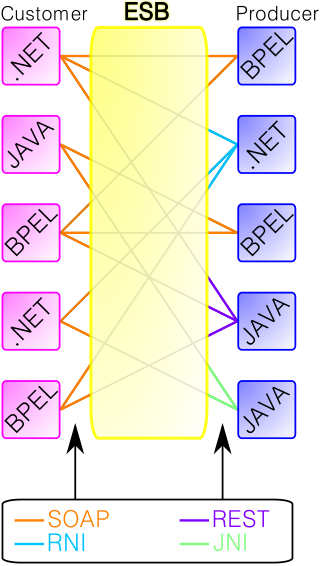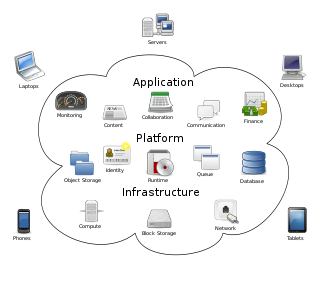Middleware in the context of distributed applications is software that provides services beyond those provided by the operating system to enable the various components of a distributed system to communicate and manage data. Middleware supports and simplifies complex distributed applications. It includes web servers, application servers, messaging and similar tools that support application development and delivery. Middleware is especially integral to modern information technology based on XML, SOAP, Web services, and service-oriented architecture.
In software engineering, service-oriented architecture (SOA) is an architectural style that focuses on discrete services instead of a monolithic design. By consequence, it is also applied in the field of software design where services are provided to the other components by application components, through a communication protocol over a network. A service is a discrete unit of functionality that can be accessed remotely and acted upon and updated independently, such as retrieving a credit card statement online. SOA is also intended to be independent of vendors, products and technologies.

An enterprise service bus (ESB) implements a communication system between mutually interacting software applications in a service-oriented architecture (SOA). It represents a software architecture for distributed computing, and is a special variant of the more general client-server model, wherein any application may behave as server or client. ESB promotes agility and flexibility with regard to high-level protocol communication between applications. Its primary use is in enterprise application integration (EAI) of heterogeneous and complex service landscapes.
In computing, Web-Based Enterprise Management (WBEM) comprises a set of systems-management technologies developed to unify the management of distributed computing environments. The WBEM initiative, initially sponsored in 1996 by BMC Software, Cisco Systems, Compaq Computer, Intel, and Microsoft, is now widely adopted. WBEM is based on Internet standards and Distributed Management Task Force (DMTF) open standards:
In computing and systems design, a loosely coupled system is one
- in which components are weakly associated with each other, and thus changes in one component least affect existence or performance of another component.
- in which each of its components has, or makes use of, little or no knowledge of the definitions of other separate components. Subareas include the coupling of classes, interfaces, data, and services. Loose coupling is the opposite of tight coupling.
A mashup, in web development, is a web page or web application that uses content from more than one source to create a single new service displayed in a single graphical interface. For example, a user could combine the addresses and photographs of their library branches with a Google map to create a map mashup. The term implies easy, fast integration, frequently using open application programming interfaces and data sources to produce enriched results that were not necessarily the original reason for producing the raw source data. The term mashup originally comes from creating something by combining elements from two or more sources.

Component-based software engineering (CBSE), also called component-based development (CBD), is a branch of software engineering that emphasizes the separation of concerns with respect to the wide-ranging functionality available throughout a given software system. It is a reuse-based approach to defining, implementing and composing loosely coupled independent components into systems. This practice aims to bring about an equally wide-ranging degree of benefits in both the short-term and the long-term for the software itself and for organizations that sponsor such software.
Open service interface definitions (OSIDs) are programmatic interface specifications describing services. These interfaces are specified by the Open Knowledge Initiative (OKI) to implement a service-oriented architecture (SOA) to achieve interoperability among applications across a varied base of underlying and changing technologies.
The Repository Open Service Interface Definition (OSID) is an Open Knowledge Initiative specification which defines the storing and retrieving of digital content, referred to as assets. OSIDs are programmatic interfaces which comprise a service-oriented architecture for designing and building reusable and interoperable software.
The scheduling open service interface definition (OSID) is an Open Knowledge Initiative specification. OSIDs are programmatic interfaces which comprise a service-oriented architecture for designing and building reusable and interoperable software.
The Workflow Open Service Interface Definition (OSID) is an Open Knowledge Initiative specification which provides the means to define a process composed of steps. OSIDs are programmatic interfaces which comprise a Service Oriented Architecture for designing and building reusable and interoperable software.
The Grading Open Service Interface Definition (OSID) is an Open Knowledge Initiative specification. OSIDs are programmatic interfaces which comprise a Service Oriented Architecture for designing and building reusable and interoperable software.
A service delivery platform (SDP) is a set of components that provides a service(s) delivery architecture for a type of service delivered to consumer, whether it be a customer or other system. Although it is commonly used in the context of telecommunications, it can apply to any system that provides a service. Although the TM Forum (TMF) is working on defining specifications in this area, there is no standard definition of SDP in industry and different players define its components, breadth, and depth in slightly different ways.
In telecommunications, Multi-Technology Operations System Interface (MTOSI) is a standard for implementing interfaces between OSSs. Service providers (carriers) use multiple Operational Support Systems (OSS) to manage complex networks. Since the various parts of the network must interact, so must the OSSs. It is standardized by the Telemanagement ForuM . The TMF Frameworx provides a set of reference models that aid in analyzing and designing next generation BSS and OSS solutions that may utilize the MTOSI interface specifications.
Service-oriented architectures (SOA) are based on the notion of software services, which are high-level software components that include web services. Implementation of an SOA requires tools as well as run-time infrastructure software. This is collectively referred to as a service-oriented architecture implementation framework or (SOAIF). The SOAIF envisions a comprehensive framework that provides all the technology that an enterprise might need to build and run an SOA. An SOAIF includes both design-time and run-time capabilities as well as all the software functionality an enterprise needs to build and operate an SOA, including service-oriented:
Service-oriented communications (SOC) technologies are designed to be easily used in the context of service-oriented architectures. These technologies are generally software based and are built more like a business application than a traditional PBX business communications system. Service-oriented communications systems allow their services to participate in business processes. They make their services available to other business applications within and SOA and allow for reuse of the services. The goal of service-oriented communications is to enable business environments to build communications into their business processes, enabling more streamlined collaboration among people within the business. It typically assumes that certain services are provided in the context of an SOA service provider. This is often in the form of a suite of web services, but may also be attached to other means of sharing the services such as an enterprise system bus (ESB).

Cloud computing is the on-demand availability of computer system resources, especially data storage and computing power, without direct active management by the user. Large clouds often have functions distributed over multiple locations, each of which is a data center. Cloud computing relies on sharing of resources to achieve coherence and typically uses a "pay as you go" model, which can help in reducing capital expenses but may also lead to unexpected operating expenses for users.

Open-system environment (OSE) reference model (RM) or OSE reference model (OSE/RM) is a 1990 reference model for enterprise architecture. It provides a framework for describing open system concepts and defining a lexicon of terms, that can be agreed upon generally by all interested parties.
In the context of software engineering and software architecture, service granularity is a key design concern when applying the paradigm of service-orientation for instance during service-oriented modeling. Service granularity specifies the scope of business functionality and the structure of the message payload in a service operation that is provided within a service-oriented architecture (SOA).
A microservice architecture – a variant of the service-oriented architecture structural style – is an architectural pattern that arranges an application as a collection of loosely-coupled, fine-grained services, communicating through lightweight protocols. One of its goals is that teams can develop and deploy their services independently of others. This is achieved by the reduction of several dependencies in the code base, allowing for developers to evolve their services with limited restrictions from users, and for additional complexity to be hidden from users. As a consequence, organizations are able to develop software with fast growth and size, as well as use off-the-shelf services more easily. Communication requirements are reduced. These benefits come at a cost to maintaining the decoupling. Interfaces need to be designed carefully and treated as a public API. One technique that is used is having multiple interfaces on the same service, or multiple versions of the same service, so as to not disrupt existing users of the code.




